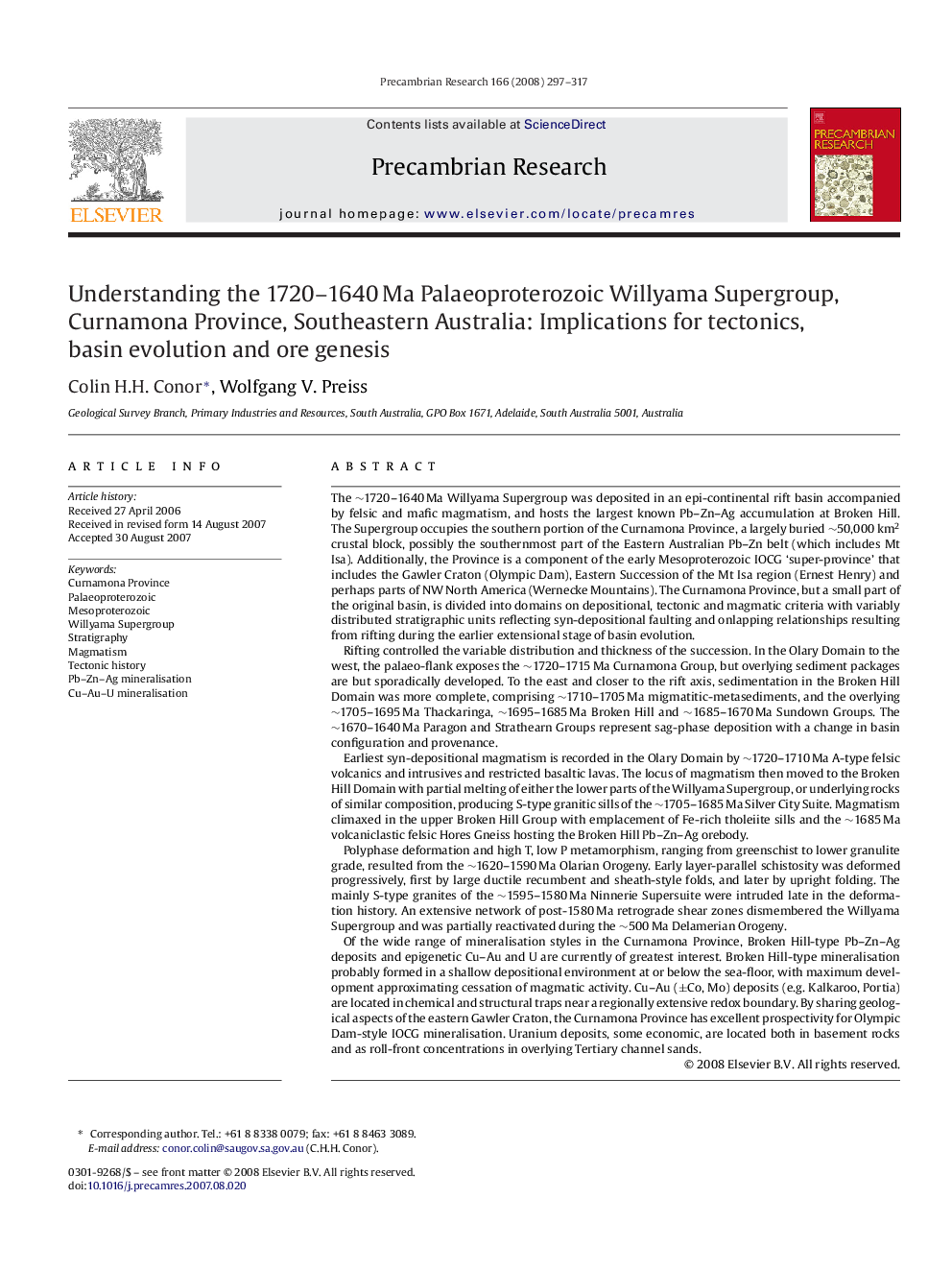| Article ID | Journal | Published Year | Pages | File Type |
|---|---|---|---|---|
| 4724320 | Precambrian Research | 2008 | 21 Pages |
The ∼1720–1640 Ma Willyama Supergroup was deposited in an epi-continental rift basin accompanied by felsic and mafic magmatism, and hosts the largest known Pb–Zn–Ag accumulation at Broken Hill. The Supergroup occupies the southern portion of the Curnamona Province, a largely buried ∼50,000 km2 crustal block, possibly the southernmost part of the Eastern Australian Pb–Zn belt (which includes Mt Isa). Additionally, the Province is a component of the early Mesoproterozoic IOCG ‘super-province’ that includes the Gawler Craton (Olympic Dam), Eastern Succession of the Mt Isa region (Ernest Henry) and perhaps parts of NW North America (Wernecke Mountains). The Curnamona Province, but a small part of the original basin, is divided into domains on depositional, tectonic and magmatic criteria with variably distributed stratigraphic units reflecting syn-depositional faulting and onlapping relationships resulting from rifting during the earlier extensional stage of basin evolution.Rifting controlled the variable distribution and thickness of the succession. In the Olary Domain to the west, the palaeo-flank exposes the ∼1720–1715 Ma Curnamona Group, but overlying sediment packages are but sporadically developed. To the east and closer to the rift axis, sedimentation in the Broken Hill Domain was more complete, comprising ∼1710–1705 Ma migmatitic-metasediments, and the overlying ∼1705–1695 Ma Thackaringa, ∼1695–1685 Ma Broken Hill and ∼1685–1670 Ma Sundown Groups. The ∼1670–1640 Ma Paragon and Strathearn Groups represent sag-phase deposition with a change in basin configuration and provenance.Earliest syn-depositional magmatism is recorded in the Olary Domain by ∼1720–1710 Ma A-type felsic volcanics and intrusives and restricted basaltic lavas. The locus of magmatism then moved to the Broken Hill Domain with partial melting of either the lower parts of the Willyama Supergroup, or underlying rocks of similar composition, producing S-type granitic sills of the ∼1705–1685 Ma Silver City Suite. Magmatism climaxed in the upper Broken Hill Group with emplacement of Fe-rich tholeiite sills and the ∼1685 Ma volcaniclastic felsic Hores Gneiss hosting the Broken Hill Pb–Zn–Ag orebody.Polyphase deformation and high T, low P metamorphism, ranging from greenschist to lower granulite grade, resulted from the ∼1620–1590 Ma Olarian Orogeny. Early layer-parallel schistosity was deformed progressively, first by large ductile recumbent and sheath-style folds, and later by upright folding. The mainly S-type granites of the ∼1595–1580 Ma Ninnerie Supersuite were intruded late in the deformation history. An extensive network of post-1580 Ma retrograde shear zones dismembered the Willyama Supergroup and was partially reactivated during the ∼500 Ma Delamerian Orogeny.Of the wide range of mineralisation styles in the Curnamona Province, Broken Hill-type Pb–Zn–Ag deposits and epigenetic Cu–Au and U are currently of greatest interest. Broken Hill-type mineralisation probably formed in a shallow depositional environment at or below the sea-floor, with maximum development approximating cessation of magmatic activity. Cu–Au (±Co, Mo) deposits (e.g. Kalkaroo, Portia) are located in chemical and structural traps near a regionally extensive redox boundary. By sharing geological aspects of the eastern Gawler Craton, the Curnamona Province has excellent prospectivity for Olympic Dam-style IOCG mineralisation. Uranium deposits, some economic, are located both in basement rocks and as roll-front concentrations in overlying Tertiary channel sands.
